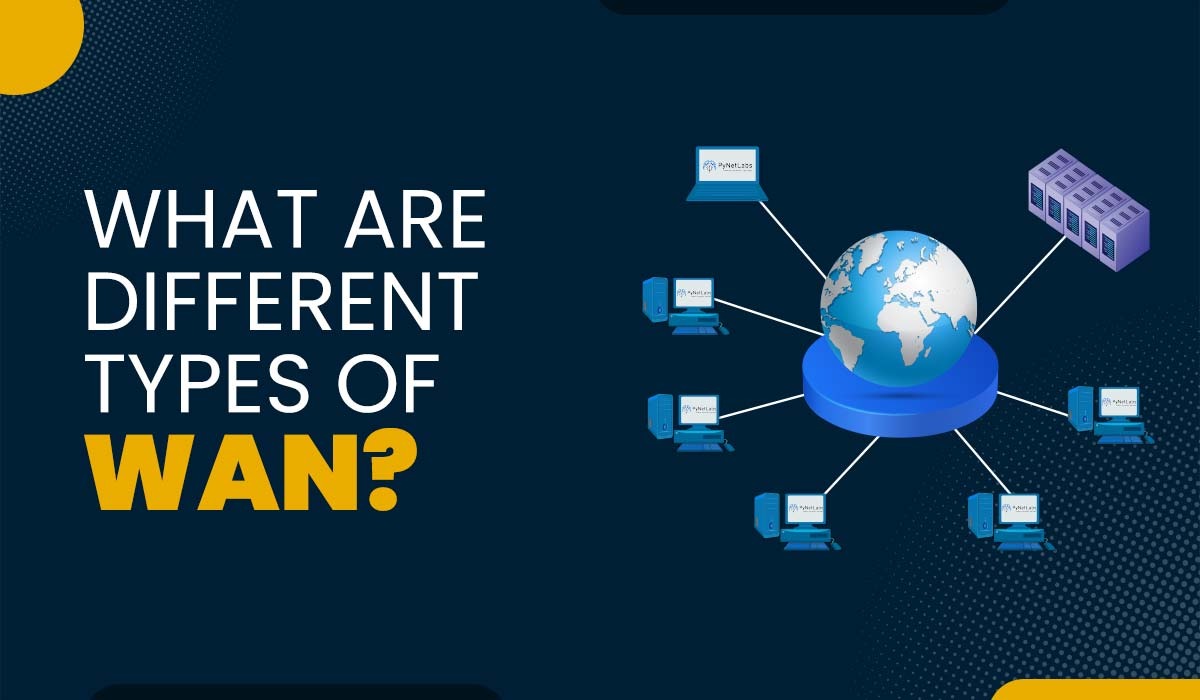Different Types of WANs

In today’s world of connectivity, Wide Area Networks (WANs) play a major role in connecting different networks irrespective of the location. This further assists in smooth communication and data transfer among clients and organizations. As cloud computing and remote work become more prevalent, having a good knowledge of the WAN types is crucial for companies that aim to enhance their network setup. In this blog, we will discuss what WAN is, types of WAN, and its architectural components. Let’s begin by first understanding what WAN really is. A Wide Area Network (WAN) is a network that covers a large geographical area that directly bridges multiple local area networks (LANs) and other network forms. Businesses and institutions commonly utilize WANs to strengthen communication and data sharing across multiple sites like branch offices or data centers. Let’s take an example for better understanding. Consider a company with offices in New York, London, and Tokyo. To allow communication among these sites, the organization would require a WAN to interconnect their networks and enable staff members to exchange resources and information between such locations. We now have a basic understanding of WAN; let’s discuss the types of WAN in detail. Businesses have several options when it comes to selecting the suitable type of WAN based on their distinct needs and criteria. There are two types of WAN, known as – Let’s understand both these WANs in detail. These networks use circuit-switching technology to create temporary connections in order to transmit data between devices. Switched WANs are commonly used for real-time communication, like voice calls and video conferencing. Establish direct connections between two devices or locations, providing dedicated communication that is both secure and reliable. They are often used to link offices or data centers with the corporate network. Apart from the two types that we just defined, WANs can also be categorized based on the underlying technology, such as Dedicated Internet Access (DIA) WAN, Broadband Internet WAN, Voice over LTE (VoLTE) WAN, MPLS WAN, and Software-defined (SD) WAN. Let’s understand these in detail. DIA offers Businesses a dedicated internet connection with consistent bandwidth for high-speed data transfer, which is crucial for mission-critical applications. Broadband Internet WANs use shared connections to provide internet access to multiple users, offering cost-effective connectivity for small and medium-sized businesses. While broadband WANs may not offer the same level of performance as DIA WANs, they are suitable for organizations with lower bandwidth requirements. Voice over LTE (VoLTE) networks allow businesses to use the infrastructure for phone calls as they do for data services, making communication more efficient. This technology is especially beneficial for organizations that heavily rely on devices. MPLS WANs utilize label-switching technology to swiftly and securely transmit data across networks catering to businesses in need of scalable networking solutions. Software-defined WANs leverage software-based tools to enhance network performance and traffic management, offering businesses flexibility and improved control over their network operations to meet evolving needs. These are the various types of WAN. Now, let’s discuss the components that complete the WAN architecture. Wide Area Network (WAN) architecture consists of various components that work together in order to establish connectivity, support communication, and guarantee data transmission across different locations. Some of the key components of WAN architecture are: Edge devices such as routers, switches, and firewalls are strategically placed at the network edges in order to connect local area networks (LANs) with the WAN. These gadgets handle the flow of information, enforce safety rules, and guide data packets to their desired destinations in the wide area network. The core network serves as the support system for the WAN infrastructure and facilitates connections between different network nodes and sites. Core routers and switches manage the flow of data across the WAN, ensuring transmission and optimal operation. WANs make use of a variety of communication channels, such as fiber optic cables, dedicated lines, satellite links, and wireless connections to send data between network endpoints. The selection of communication channels depends on factors like needs, distance, reliability, and cost considerations. Connectivity links in WANs establish links between network sites to enable data exchange among different locations. Common types of connectivity links include T1/E1 lines, T3/E3 lines, MPLS circuits, broadband internet connections, and virtual private networks (VPNs). WANs rely on communication protocols to regulate how data is structured, transmitted, and received across the network. Protocols like TCP/IP, BGP (Border Gateway Protocol), OSPF (Open Shortest Path First), and MPLS define regulations for data exchange processes, routing mechanisms, addressing systems, and error detection methods to ensure functioning and reliability within the WAN. WANs provide a range of networking services to facilitate communication and collaboration across dispersed locations. Services like voice over IP (VoIP), video conferencing, unified communications, and cloud connectivity enhance productivity and enable seamless interaction between users on the WAN. Security plays a major role in WAN architecture. With a range of security measures in place to safeguard data prevent access as well as combat cyber threats. Firewalls, intrusion detection systems (IDS), virtual private networks (VPNs), encryption, and access control mechanisms are utilized to protect the WAN infrastructure and secure sensitive information. WAN management tools and monitoring solutions help IT teams oversee network performance, troubleshoot issues, optimize resource utilization, and ensure compliance with service level agreements (SLAs). Network monitoring tools provide real-time visibility into network traffic, bandwidth utilization, and device status, enabling proactive network management. By integrating these architectural components effectively, organizations can design and deploy a robust WAN infrastructure that meets their connectivity requirements, supports business operations, and enables seamless communication and collaboration across distributed locations. Yes, there are two types of WAN. These are: The three major WAN topologies are: The most common types of WAN are: Apart from these two, there are many others, such as MPLS WAN, VoIP WAN, etc. The two types of WAN providers are satellite and telephone companies. Wide Area Networks (WAN) are essential for businesses looking to connect geographically dispersed locations and enable seamless communication and data transfer. In this blog, we have explained what WAN is, the different types of WAN, and the different components of WAN architecture. If you have any queries or suggestions, please feel free to use the comment section below.Introduction
What is Wide Area Network (WAN)?
Different Types of WAN
Switched WANs
Point-to-Point WANs
Dedicated Internet Access (DIA) WAN
Broadband Internet WAN
Voice over LTE (VoLTE) WAN
MPLS WANs
Software-defined WANs
WAN Architecture Components
Edge devices
Core Network
Communication Channels
Connectivity Links
Communication Protocols
Networking Services
Security Mechanisms
Management and Monitoring Tools
Frequently Asked Questions
Q1. Are there two types of WAN?
Q2. What are the 3 major WAN topologies?
Q3. What is the most common type of WAN?
Q4. What are two types of WAN providers?
Conclusion







